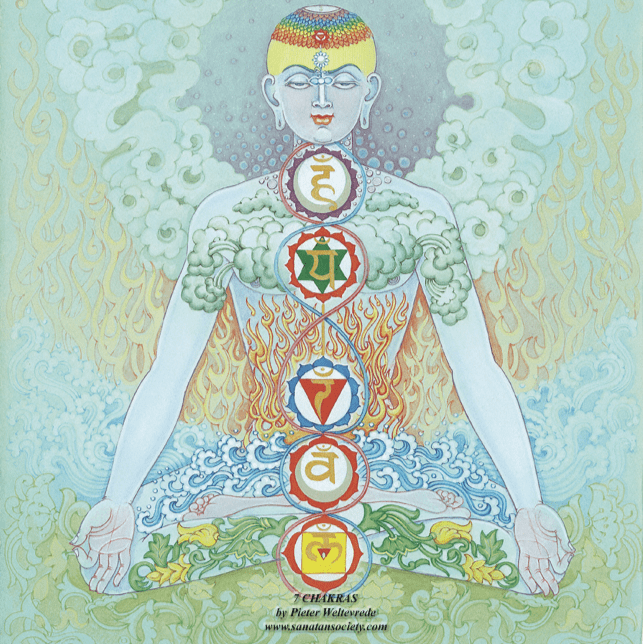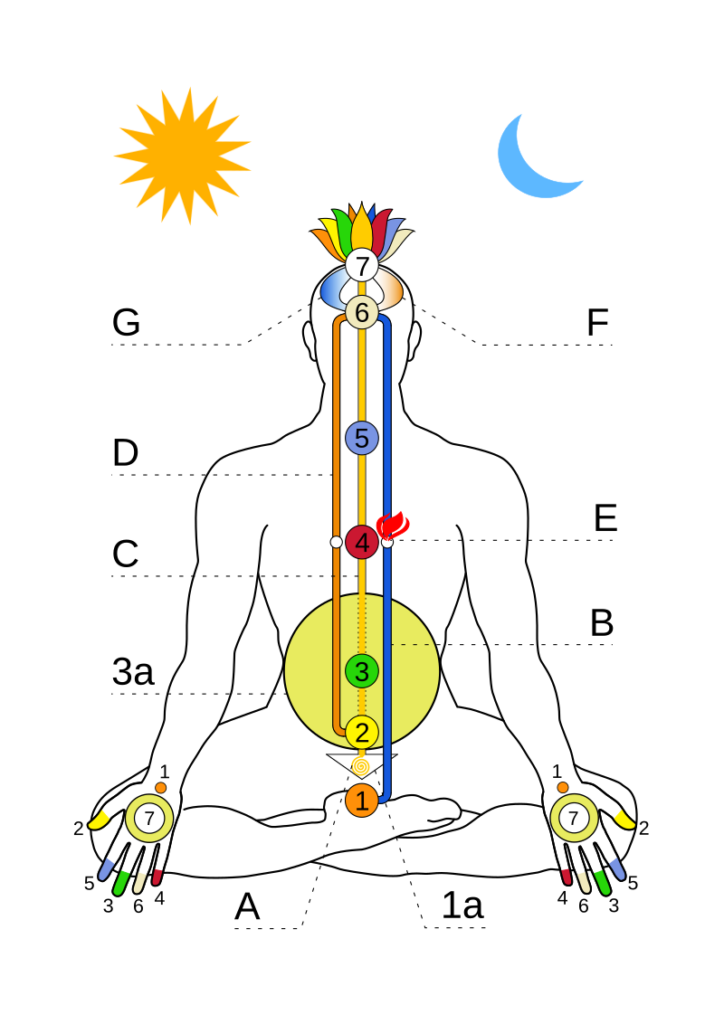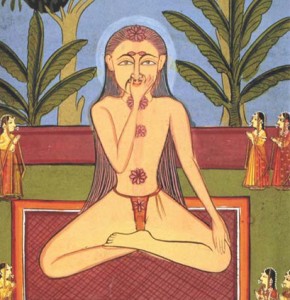
Kundalini Yoga is an approach within Tantra Yoga that focuses on awakening the Kundalini energy and directing it through the energy centers of the body. The theory behind this form of yoga is based on the concept that an immense power lies dormant in the human body, which can be awakened through proper practice. This power is prana (life energy), which is concentrated in the Shusumna Nadi and rises from the bottom to the top as Kundalini energy.
This force, known as Kundalini, is symbolically represented as a coiled snake at the lower end of the spine in the area of the Muladhara chakra (root chakra). Special techniques are used to awaken this energy and guide it upwards along the spine through the seven main chakras until it finally reaches the Sahasrara chakra (crown chakra).
General information about Kundalini Yoga
As a practitioner of mantra meditation and based on personal experience, I would like to clarify the topic of Kundalini at the beginning of this article. We cannot force Kundalini to become active, nor can we control Kundalini energy. However, by purifying the koshas, we can create the conditions for Kundalini activation.
We will never be able to consciously realize the full activation of Kundalini, because when this happens, we are in the state of Samadhi – the deepest state of meditation. The most natural and safest way to activate the Kundalini energy is therefore the ability to go into deep meditation.
Origin and historical development
The origins of this form of yoga can be traced back to the ancient Vedic scriptures, which were written in India over 5000 years ago. These scriptures, in particular the Upanishads, contain detailed descriptions of the energies in the human body and their connection to higher levels of consciousness. A key text explaining the concept of Kundalini is the Hatha Yoga Pradipika, written by Swatmarama in the 15th century. This text describes various techniques for its awakening and movement through the chakras.
Another important text is the Shiva Samhita, a work from the 17th century that details the various practices for strengthening the kundalini energy. The Gheranda Samhita, another classic of hatha yoga, also contains detailed instructions on awakening and directing this energy. It was not until the 20th century that the spiritual teacher Yogi Bhajan brought this practice to the West and made it accessible to a wider public.

Sushumna, Ida and Pingala
The principle of Kundalini, depicted as a coiled snake in our pelvis, refers to our spiritual potential and also serves as a beautiful parable for it. However, we can only ever create the conditions for Kundalini to rise. The safest way to awaken Kundalini is through deep meditation. Under the supervision of an experienced teacher, we can actively influence the process by removing blockages so that the Kundalini decides to rise of its own accord. This ascent then takes place in the Shusumna Nadi.
Sushumna Nadi
Shusumna Nadi is translated from Sanskrit as “channel”. This channel is considered the most important nadi in the entire energy system of the body, as it connects the chakras along the spine up to the head. It is important to understand that we humans have emotional and energetic blockages in the chakras.
Meditation is considered so safe because deep meditation requires a certain balance in the chakras. When the Kundalini rises, this happens naturally and safely. However, if we try to set the Kundalini in motion through energetic techniques and it encounters deep-seated blockages in the chakras, these are only strengthened.
Ida and Pingala
Ida flows on the left side of the body and symbolizes the lunar energy, while Pingala flows on the right side and represents the solar energy. Both nadis cross each other along the spine and finally meet in the Shusumna Nadi. Without the balance of Ida and Pingala, the Kundalini energy cannot rise.
Kundalini is concentrated prana
Prana is the energy that permeates the entire universe. In yoga, we also define prana as life energy and describe its various functions in the body. Prana heals the cells in the body and is responsible for many processes, such as digestion. When the kundalini rises through the shusumna nadi, the prana in this channel contracts.
Kundalini energy is therefore concentrated prana. In this state, all processes in the body slow down and even the breath and heartbeat can come to a standstill for a longer period of time.

Techniques in Kundalini Yoga
These techniques should be practiced under the supervision of an experienced teacher. They include classic Hatha Yoga techniques with a focus on Kriya Yoga – the cleansing of the gross and subtle body. In addition, the energy in the root chakra is activated to trigger the Kundalini, so to speak.
- Asanas (postures): Compared to other yoga styles, this practice places particular emphasis on dynamic sequences aimed at activating the energy in the nadis (energy channels) and releasing blockages. The basic focus is on stretching and strengthening the spine.
- Pranayama (breathing exercises): Breathing techniques are crucial to controlling the energy in the body. Techniques such as “fire breathing” (Kapalabhati) or “alternate breathing” (Nadi Shodhana) play a central role.
- Mudras (hand gestures) and bandhas (body locks): Certain hand gestures and body locks are used to channel and concentrate the energy in the body. A frequently used mudra is the Gyan Mudra, in which the thumb and index finger are brought together. Bandhas such as the mula bandha (root lock) help to hold the energy in the body and channel it upwards.
- Mantras (sound vibrations): The use of mantras, such as “Sat Nam” or “Ong Namo”, is another important aspect. Mantras use the power of sound and vibration to focus the mind and increase energy. In this yoga practice, mantras are often used in combination with breathing techniques and meditation.
- Meditation: Ultimately, we will never achieve Kundalini awakening without meditation. We may have an experience of Kundalini here and there, but a full awakening takes place in Samadhi, the stage of complete absorption with the Self.
Instruction for Kirtan Kriya
- Position: Sit in a comfortable, upright position, either cross-legged (Sukhasana) or on a chair with your feet flat on the floor. Keep the spine straight and the hands on the knees with the palms facing upwards.
- Mantra: Start to say the mantra “Sa Ta Na Ma” out loud. This mantra represents the life cycle: “Sa” means birth, “Ta” means life, “Na” means death and “Ma” means rebirth. Each syllable should be recited as you exhale.
- Mudras: While reciting the mantra, perform the following mudras with your fingers:
- “Sa”: Press your thumbs and index fingers together.
- “Ta”: Press your thumbs and middle fingers together.
- “Na”: Press your thumbs and ring fingers together.
- “Ma”: Press your thumbs and little fingers together.
- Breath: Breathe calmly and evenly while repeating the mantra. Start with the sound of the mantra, then switch to a whisper after a few minutes and finally to a silent repetition in your mind. Return in reverse order – from silent repetition to whispering and then become louder again.
- Duration: This meditation can take 10 to 30 minutes. A common structure is: 5 minutes out loud, 5 minutes whispering, 10 minutes silent, 5 minutes whispering and 5 minutes out loud.
- Conclusion: End the meditation by inhaling deeply, mentally repeating the mantra and exhaling slowly. Let your hands rest and feel the energy flowing through your body. Remain in silence for a few minutes.